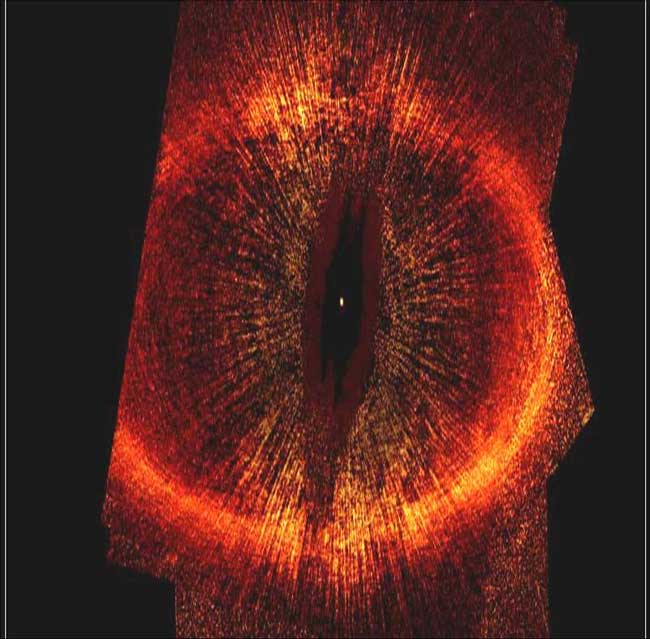Pluto-Sized Planet Embryos Detected

Puffy debris disks around three nearby stars could harbor Pluto-sized planets-to-be, a new computer model suggests.
The "planet embryos" are predicted to orbit three young, nearby stars, located within about 60 light years or less of our solar system. AU Microscopii (AU Mic) and Beta Pictoris (Beta Pic) are both estimated to be about 12 million years old, while a third star, Fomalhaut, is aged at 200 million years old.
If confirmed, the objects would represent the first evidence of a never-before-observed stage of early planet formation. Another team recently spotted "space lint" around a nearby star that pointed to an even earlier phase of planet building, when baseball-sized clumps of interstellar dust grains are colliding together.
The new finding will be detailed in an upcoming issue of the Monthly Notices of the Royal Astronomical Society.
Planet puffer-uppers
Using NASA's Hubble Space Telescope, the researchers measured the vertical thickness of so-called circumstellar debris disks around the stars, and then used a computer model to calculate the size of planets growing within them.
The thickness of a debris disk depends on the size of objects orbiting inside it. The ring of dust thins as the star system ages, but if enough dust has clumped together to form an embryonic planet, it knocks the other dust grains into eccentric orbits. Over time, this can puff up what was a razor-thin disk.
Breaking space news, the latest updates on rocket launches, skywatching events and more!
The new model the researchers created predicts how large the bodies in a disk must be to puff it up to a certain thickness. The results suggest that each of the three stars studied is harboring a Pluto-sized embryonic planet.
"Even though [the disks] are pretty thin, they turn out to be thick enough that we think there's something in there puffing them up," said study team member Alice Quillen of the University of Rochester in New York.
At least one of the stars is thought to contain at least one other planet in addition to the circling Pluto-sized planet. The circumstellar disk of Fomalhaut contains a void that scientists think is being cleared out by a Neptune-sized world. The researchers think the embryonic planets predicted by their model are too small to clear gaps like this in the disk.
"If you think of water flowing over pebbles, if the pebbles are very small at the bottom of the water, it doesn't make a good ripple," Quillen told SPACE.com.
Too far?
All of the embryonic planets predicted to exist in the three systems are located far away from their parent stars. Au Mic's budding planet is estimated to lie about 30 AU from its star, or about the same distance that Pluto is from our sun. One AU is equal to the distance between Earth and the sun. The embryonic planets of Beta Pic and Fomalhaut are thought to lie even farther, at 100 and 133 AU, respectively.
It is the large distances separating the planet embryos and their stars that have drawn the most criticism by colleagues, Quillen said. Many find it hard to believe that any planet, even a diminutive Pluto-sized one, could form at such a far distance.
According to the standard theory of how our solar system formed, Pluto formed much closer to the sun but was then knocked out to its current orbit due to instability in the inner solar system. However, there are objects in our solar system that are located even further from our sun and are difficult to explain by this theory. Sedna, for example, is about three-fourths the size of Pluto and is located about three times farther from the sun.
Mordecai-Marc Mac Low, an astrophysicist at the American Museum of Natural History in New York City who was not involved in the study, said the new model should be viewed as a plausibility argument for the presence of Pluto-sized objects rather than proof of their existence.
“The work presented here shows that Pluto-sized objects stirring disks are consistent with the observed disk thicknesses and other properties,” Mac Low said.
James Graham, an astronomer at the University of California, Berkeley, who was also not involved in the study, expressed a similar sentiment. “This calculation is making a bold extrapolation,” Graham said in an email interview. “It’s bit like describing an elephant given a single cell from that animal. With enough knowledge, this is possible—if you know enough about microbiology and genetics and could read the DNA in the cell and in principle envision the entire creature.”
Quillen is now looking for more young stars to investigate with her model, but the criteria to be a candidate are strict. The systems have to be young enough to still have their circumstellar disks, but old enough to be forming embryonic planets. They must also appear edge-on as seen from Earth and be near enough that Hubble can accurately discern the thickness of their disks.
At the moment, the three stars Quillen has already observed appear to be the only candidates that meet all the standards.
- Top 10 Most Intriguing Extrasolar Planets
- Major Planet Formation Mystery Solved
- VIDEO: Planet Hunter
Ker Than is a science writer and children's book author who joined Space.com as a Staff Writer from 2005 to 2007. Ker covered astronomy and human spaceflight while at Space.com, including space shuttle launches, and has authored three science books for kids about earthquakes, stars and black holes. Ker's work has also appeared in National Geographic, Nature News, New Scientist and Sky & Telescope, among others. He earned a bachelor's degree in biology from UC Irvine and a master's degree in science journalism from New York University. Ker is currently the Director of Science Communications at Stanford University.
